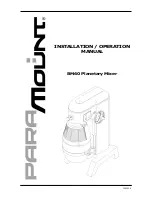
GB
33
OPERATION OF THE HAND MIXER
1. Set the speed selection to the whisk release position and insert the appropriate accessories. Connect the
power plug into the power socket.
2. Switch the speed selection to the required speed and start to mix.
The mixer will run at the highest speed, if you press the TURBO button.
Tip:
First insert the whisks or the hooks into the foods and then start mixing and gradually increase the
speed so as to avoid splashing out the bowl contents.
When adding dry ingredients use the slowest speed to avoid the “snow storm” effect.
3. The maximum operating speed should not be longer than 5 minutes and between two such sessions
there should be a break of at least 10 minutes. When kneading yeast dough set the speed selection
at 1 or 2, and then set it to maximum – in this way you will achieve better results. As soon as the mix is
complete, turn the speed selection to the whisk release position and pull out the power plug from the
power socket.
4. Use a spatula to wipe off the remaining dough or mix on the whisks or hooks.
5. Disassembly of the whisks/hooks: gently hold the whisks or hooks and firmly press the speed control.
EXAMPLE OF MIXER APPLICATIONS
Food
Amount
Recommended speed
Operating time
Children's soup
0.5 litres
Speed 2
40–60 s
Vegetables: dill
One bundle
Speed 1
30 s
Pancake dough
0.5 litres
Speed 3
90–120 s
Mashed potatoes
0.25 kg
Speed 5
120 s
Cottage cheese with additions
0.25 kg
Speed 4
180 s
Fruit cocktail
0,15 kg of fruit
0.3 litres of milk
Speed 5
180 s
Only for domestic use
CLEANING AND MAINTENANCE
1. Before cleaning the product remove the power plug from the power socket and allow it to fully cool
down.
2. Wipe the external parts of the product using a damp cloth and wipe until dry.
3. Remove food remains from the power cord.
4. Wash the whisks and hooks in warm soapy water and wipe dry. You can wash the whisks and hooks in a
dishwasher.
USAGE TIPS
1. Refrigerated ingredients e.g. butter and eggs should be at room temperature before mixing. Therefore
take these ingredients out of the fridge a sufficient time before their processing.
2. Prepare all the ingredients and needs near the mixer.
3. To prevent egg shells or rotten eggs from getting into the mix, first break the egg into a separate
container and only then add to the other ingredients.
4. When whipping egg white make sure that the bowl and the whisks are clean and dry. Even a small
amount of fat on the whisks or in the bowl can prevent the whites from frothing.
5. Always start whipping slowly. Gradually increase the speed to that recommended in the recipe.
6. Do not over whip. Make sure to only whip the ingredients that you have in the recipe. Mix in dry
ingredients carefully. Always use the lowest speed. At any stage in the mixing process over whipping
can cause hardening, prevent rising or shrinkage of the mix. Climatic conditions, seasonal temperature
changes, temperature of ingredients or their structure – all this plays a role in setting the whipping
duration and achieving the desired results.
















































